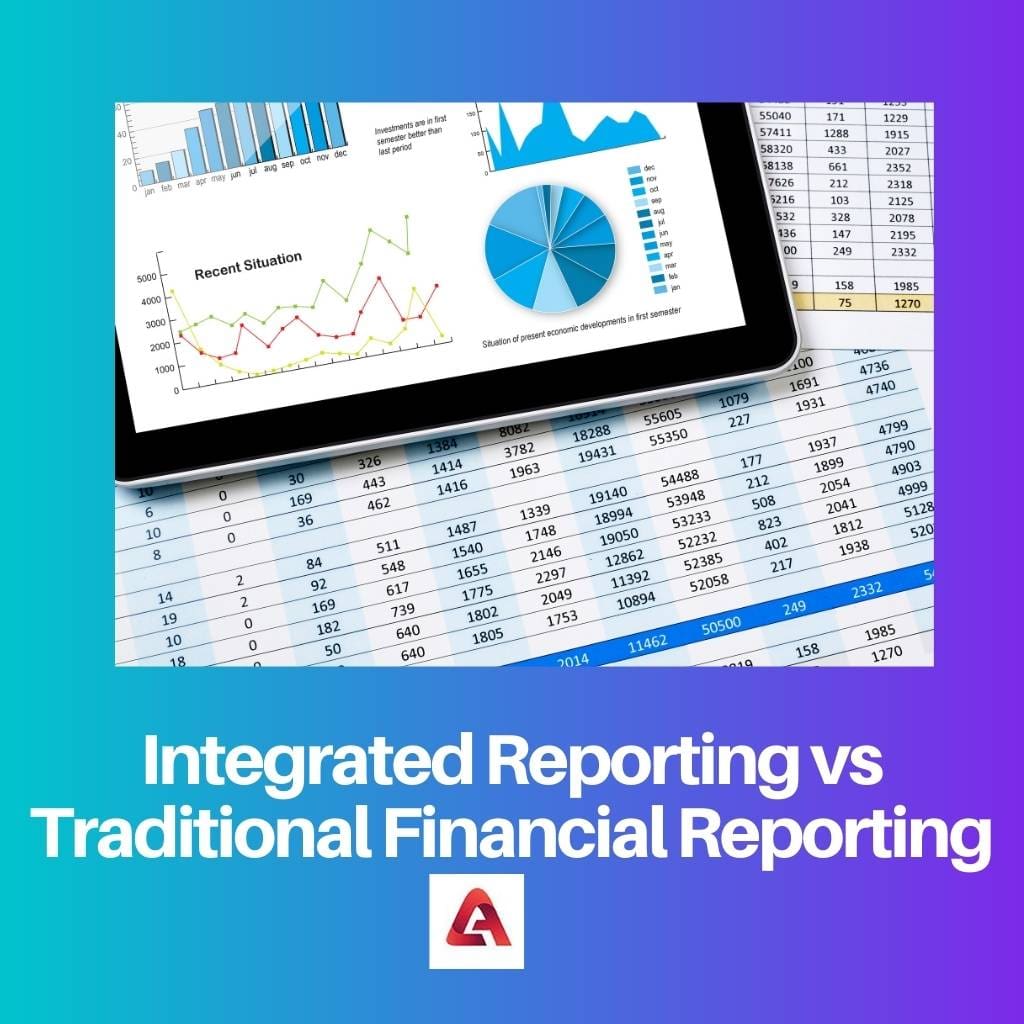In business, maintaining reports is not an easy task. It is very difficult, and without any proper guidelines in this method, it will become a loss for the company.
There are many techniques for collaborating with stakeholders and focusing on shareholders. Many companies prefer integrated reporting and traditional financial reporting for these methods.
Key Takeaways
- Integrated Reporting combines financial, environmental, social, and governance aspects in a single report.
- Traditional Financial Reporting focuses solely on a company’s financial performance and position.
- Integrated Reporting is more comprehensive and supports long-term value creation for stakeholders.
Integrated Reporting vs Traditional Financial Reporting
Integrated reporting is a reporting framework with financial and non-financial information. Traditional financial reporting only includes financial data. Integrated reporting is focused on sustainability and long-term value, while traditional financial reporting focus on financial performance.

Integrated reporting helps us to collaborate with many companies, which results in more stakeholders for the company.
There are seven principles that are followed in integrated reporting Strategic Focus and orientation of the future, Connecting Information, Relationships with Stakeholders, Materiality, Conciseness, Reliability, Completeness, Consistency, and Comparability.
Traditional financial reporting can be divided into two categories such as external financial reporting and internal financial reporting. Its main aim is focused on the shareholders of the company.
The main objective of traditional financial reporting is to prepare and publish the related financial statements of the company. It is not only useful for shareholders. It is also useful for those who are interested.
Comparison Table
| Parameters of Comparison | Integrated Reporting | Traditional Financial Reporting |
|---|---|---|
| Definition | It collaborates with many companies to increase stakeholders. | It is focused on the shareholders of the company. |
| Advantages | It is a single report; therefore, it is easier to access. | It uses straightforward techniques and tools. |
| Disadvantages | Data analysis will be difficult. | It fails to meet the information of the stakeholders. |
| Government Body | This method is promoted by the international integrated reporting council. | This method is promoted by the international accounting standards board. |
| Information | This method focuses on both financial and non-financial information. | This method focuses only on financial information. |
What is Integrated Reporting?
Integrated reporting is the communication that happens in the corporate sector. It provides information about that organization’s strategy, its performance, and the leads generated.
All these things happen either in the long term or short term. The main purpose of integrated reporting is to explain the things that are happening financially. It contains all the information related to both financial and other aspects.
We need Integrated Reporting to disclose the financial aspects of the company. This will provide a transparent clear-cut image in front of society. It will help us to improve our company’s levels.
It helps to identify how a company creates this social value, especially over time. It is also called as Integrated Reporting Pilot Programme. It is shortly called IRRP. This program first came into existence in 2011, and it was launched by IRRC.
This company is one of the best multinational companies in the world.
There are around 1600 companies that are using this integrated reporting in their company. It is used in 64 countries worldwide. This comes under the accounting sector. In order to learn this, students should have opted for commerce in this 11th class.
It will again continue in their higher studies as well. They will implement this method in the workplace. But it again depends upon the nature of the place they work with.

What is Traditional Financial Reporting?
Traditional Financial Reporting is used to give details of the organization regarding reports and its related financial services. It will give details related to financing in the form of the date when it is invested, its performance, changes, and everything in a precise form.
The content can include the company’s assets, liabilities, ownership structure, income statement, profits, and losses. We can also get information regarding the cash flows as well.
In traditional reporting, the results can be included in the form of an Excel sheet or a PowerPoint presentation. In recent days traditional financial reporting has failed to answer customer queries.
This created a huge impact on this method. And customers are seeking some other methods to move. But on the other hand, it is one of the most powerful methods in the area of finance.
This method will give the exact values, and it is good for knowing specific table calculations. Statistical data methods can be answered by this traditional financial reporting method. It is one of the important topics in reporting section.
It failed to answer the ability of long-term direction of the company, but traditional reporting has answered that query, and many business organizations are moving to that side.

Main Differences Between Integrated Reporting and Traditional Financial Reporting
- Integrated Reporting is mostly used in all businesses, and it is adopted by many companies. On the other hand, traditional financial reporting is practised only in industrial sectors.
- Integrated Reporting’s main aim is to connect all the stakeholders, while traditional financial reporting will be profitable for shareholders.
- In integrated, the information will be focussed on two sectors. On the other hand, in traditional financial reporting, the information will be focused on only one sector.
- The main focus of integrated reporting is to maintain different types of reports that come under the financial sector. Traditional reporting, its focus will be only on the shareholders.
- Integrated reporting engages almost all sectors. But traditional financial reporting only engages stakeholders only when they are important to the business.

- https://www.emerald.com/insight/content/doi/10.1108/IJAIM-10-2019-0124/full/html
- https://www.sciencedirect.com/science/article/pii/S0969593113000085

Traditional financial reporting is essential for capturing specific statistical data and accurate financial values, catering to the needs of shareholders and stakeholders alike.
Absolutely, traditional financial reporting is indispensable in providing detailed financial insights.
It’s important to recognize that traditional financial reporting still holds relevance in addressing specific financial queries and data requirements.
Traditional financial reporting is focused on providing financial data to shareholders. It has its advantages but may not be as comprehensive as integrated reporting.
Exactly, traditional financial reporting is limited to the financial performance and doesn’t consider the broader aspects of an organization.
Traditional financial reporting method may be more limited than integrated reporting, but it serves its purpose in providing accurate financial data and statistical information.
The precision and reliability of traditional financial reporting make it a crucial tool for certain financial calculations and analyses.
Indeed, traditional financial reporting is still valuable in specific areas of financial analysis.
The shift towards integrated reporting is essential for transparency and creating a clear image of the company’s social value.
Integrated reporting is crucial in showcasing how a company creates social value over time and aligns with the expectations of various stakeholders.
I agree, it’s important for companies to be transparent about their social impact.
Both integrated reporting and traditional financial reporting have unique strengths and are valuable in their own contexts. It’s important to harness the benefits of each reporting method according to the specific needs and objectives of an organization.
Agreed, organizations can leverage integrated reporting and traditional financial reporting to meet diverse informational needs effectively.
Integrated reporting is an essential aspect of an organization. It enriches the information shared with stakeholders by including financial as well as non-financial data.
I agree, stakeholders need all-encompassing information to make informed decisions.
Integrated reporting being widely used in 64 countries is a testament to its effectiveness in providing comprehensive insights into an organization’s operations.
The international reach of integrated reporting is impressive and indicates its relevance in the modern business world.
Absolutely, the global adoption of integrated reporting reflects its significance.
The international integrated reporting council and the international accounting standards board play key roles in promoting integrated and traditional financial reporting, respectively.
Integrated reporting pilot program has played a pivotal role in the widespread adoption of integrated reporting among multinational companies across the globe.
Indeed, IRRP has brought about a positive shift in reporting practices globally.
The integrated reporting pilot program has significantly contributed to enhancing the understanding and use of integrated reporting principles.
Integrated reporting principles like materiality and reliability ensure that the information presented is accurate and meaningful to stakeholders.
Indeed, these principles are integral in maintaining the integrity of the reports.